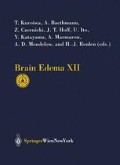Abstract
Hemodynamic changes following traumatic brain injury (TBI) may reflect cellular damage leading to secondary injury. The purpose of this study was to investigate the regional hemodynamic parameters acutely after TBI among regions in and around contusions. Sixteen patients (11 male, 5 female) showing evidence of contusion on CT and 18 normal volunteers (12 male, 6 female) underwent positron emission tomography (PET) with O-15 CO and O-15 H2O to estimate cerebral blood volume (CBV) and cerebral blood flow (CBF), respectively. A flow to volume ratio (FVR = CBF/CBV) was also calculated as an index of vasodilatation. The hemodynamic parameters were compared among contusion, pericontusion, and remote areas. Globally, hemodynamic parameters did not differ between patients and normal volunteers, and did not correlate with intracranial pressure (ICP). Regionally, contusional and pericontusional areas showed significantly lower CBF and FVR compared with normal volunteers, while CBV did not differ significantly. The correlation between CBF and CBV was significant (r = 0.37, p < 0.01). Remote areas did not show a significant difference in any of the PET parameters. In conclusion, regional brain edema is likely to occur in contusion and pericontusion areas, while some of the contusional tissue may show vascular engorgement.
Access this chapter
Tax calculation will be finalised at checkout
Purchases are for personal use only
Preview
Unable to display preview. Download preview PDF.
References
Alexander MJ, Martin NA, Khanna R, Caron M, Becker DP (1994) Regional cerebral blood flow trends in head injured patients with focal contusions and cerebral edema. Acta Neurochir (Wien) [Suppl) 60: 479–481
Bullock RM, Chestnut RM, Clifton GL, Ghajar J, Marion DW, Narayan RK, Newell DW, Pitts LH, Rosner MJ, Waiters BC, Wilberger JE (2000) Guidelines for the management of severe head injury. Brain Trauma Foundation, American Association of Neurological Surgeons, Joint section on neurotrauma and critical care. J Neurotrauma 17: 449–627
Di X, Goforth PB, Bullock R, Ellis E, Satin L (2000) Mechanical injury alters volume activated ion channels in cortical astrocytes. Acta Neurochir (Wien) [Suppl) 76: 379–383
Hovda DA, Becker DP, Katayama Y (1992) Secondary injury and acidosis. J Neurotrauma 9 [Suppl) 1: S47–60
Marmarou A, Fatouros PP, Barzo P, Portella G, Yoshihara M, Tsuji O, Yamamoto T, Laine F, Signoretti S, Ward JD, Bullock MR, Young HF (2000) Contribution of edema and cerebral blood volume to traumatic brain swelling in head-injured patients. J Neurosurg 93: 183–193
Marmarou A, Portella G, Barzo P, Signoretti S, Fatouros P, Beaumont A, Jiang T, Bullock R (2000) Distinguishing between cellular and vasogenic edema in head injured patients with focal lesions using magnetic resonance imaging. Acta Neuro chir (Wien) [Suppl) 76: 349–351
Powell MJD (1964) An efficient method for finding the minimum of a function of several variables without calculating derivatives. Comput J 7: 155–162
Press WH, Teukolsky SA, Vetterling WT, Flannery BP (1992) Numerical recipes in C 2 edn. Cambridge University Press, Cambridge University Press
Schroder ML, Muizelaar JP, Bullock MR, Salvant JB, Povlishock JT (1995) Focal ischemia due to traumatic contusions documented by stable xenon-CT and ultrastructural studies. J Neurosurg 82: 966–971
Schroder ML, Muizelaar JP, Kuta AJ, Choi SC (1996) Thresholds for cerebral ischemia after severe head injury: relationship with late CT findings and outcome. J Neurotrauma 13: 17–23
Tenjin H, Ueda S, Mizukawa N, Imahori Y, Hino A, Yamaki T, Kuboyama T, Ebisu T, Hirakawa K, Yamashita M, Nakahashi H (1990) Positron emission tomographic studies on cerebral hemodynamics in patients with cerebral contusion. Neurosurgery 26: 971–979
Author information
Authors and Affiliations
Corresponding author
Editor information
Editors and Affiliations
Rights and permissions
Copyright information
© 2003 Springer-Verlag Wien
About this paper
Cite this paper
Hattori, N. et al. (2003). PET investigation of post-traumatic cerebral blood volume and blood flow. In: Kuroiwa, T., et al. Brain Edema XII. Acta Neurochirurgica Supplements, vol 86. Springer, Vienna. https://doi.org/10.1007/978-3-7091-0651-8_11
Download citation
DOI: https://doi.org/10.1007/978-3-7091-0651-8_11
Publisher Name: Springer, Vienna
Print ISBN: 978-3-7091-7220-9
Online ISBN: 978-3-7091-0651-8
eBook Packages: Springer Book Archive

